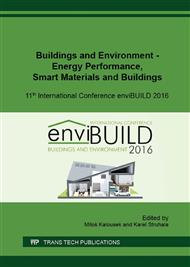[1]
Directive 2010/31 EU of the European Parliament and the Council of 19 May 2010 on the energy performance of buildings. Official Journal of the European Communities. L 153/21-2.
Google Scholar
[2]
Ø. Økland, Convection in Highly – Insulated Building Structures. Doctoral theses at NTNU. Norwegian University of Science and Technology, Department of Building and Construction Engineering, Trondheim, (1998).
Google Scholar
[3]
C. Belleudy, A. Kayello, M. Woloszyn, H. Ge, Experimental and numerical investigations of the effects of air leakage on temperature and moisture fields in porous insulation, Build. Env. 94 (2015) pp.457-466.
DOI: 10.1016/j.buildenv.2015.10.009
Google Scholar
[4]
C. Deseyve, T. Bednar, Wind induced airflow through lightweight pitched roof construction: Test roof element – measurements and model validation, proceedings of the 8th Symposium on Building Physics in the Nordic Countries, Kopenhaga, (2008).
Google Scholar
[5]
S. Roels, J. Langmans, R. Klein, Hygrothermal risks of using exterior air barrier systems for highly insulated light weight walls: A laboratory investigation, Build. Env. 56 (2012) pp.192-202.
DOI: 10.1016/j.buildenv.2012.03.007
Google Scholar
[6]
D. Watt, S. Sjöberg, P. Wahlgren, Hygrothermal performance of a light weight timber wall assembly with an exterior air barier, En. Proc. 78 (2015) pp.1419-1424.
DOI: 10.1016/j.egypro.2015.11.164
Google Scholar
[7]
R. Wójcik, P. Kosiński, Seeming air tightness of construction partitions, En. Proc. 78 (2015) pp.1519-1524.
DOI: 10.1016/j.egypro.2015.11.181
Google Scholar
[8]
D. Bosia, L. Savio, F. Thiebat, A. Patrucco, S. Fantucci, G. Piccablotto, D. Marino, Sheep wool for sustainable architecture, En. Proc. 78 (2015) pp.315-320.
DOI: 10.1016/j.egypro.2015.11.650
Google Scholar
[9]
H. R. Kymäläinen, A. M. Sjöberg, Flax and hemp fibres as raw materials for thermal insulations, Building and Environment. 43 (2008) p.1261–1269.
DOI: 10.1016/j.buildenv.2007.03.006
Google Scholar
[10]
M. A. Tarallo, Bio-Fibers and Their Use in Thermal Insulation Material, Syracuse University, New York, (2010).
Google Scholar
[11]
P. Brzyski, D. Barnat-Hunek, P. Smarzewski, Possibilities of using hemp-flax composites in low-energy building construction, Wulf. 23 (2016) pp.82-101.
DOI: 10.1080/15440478.2016.1212764
Google Scholar
[12]
P. Skotniczny, Model przepływu powietrza w ośrodku porowatym z uwzględnieniem wewnętrznych źródeł ciepła, Prace Instytutu Mechaniki Górotworu PAN. 10 (2008) p.103‒113.
Google Scholar
[13]
W. Sobieski, A. Trykozko, Sensitivity Aspects of Forchheimer's Approximation, Trans. in Por. Med. 89 (2011) p.155–164.
Google Scholar
[14]
T.O. Relander, J.V. Thue, A. Gustavsen, Air tightness performance of different sealing methods for windows in wood-frame buildings, proceedings of the 8th Symposium on Building Physics in the Nordic Countries, Kopenhaga, (2008).
Google Scholar
[15]
ISO 9053: 2011 Acoustics - Materials for acoustical applications - Determination of airflow resistance.
Google Scholar
[16]
EN 12114 Thermal performance of buildings - Air permeability of building components and building elements - Laboratory test method.
DOI: 10.3403/01700173u
Google Scholar
[17]
ISO 9869, Thermal insulation – Building elements – In-situ Measurements of thermal resistance and thermal transmittance.
DOI: 10.3403/bsiso9869
Google Scholar
[18]
Information on http: /www. bauklimatik-dresden. de/delphin.
Google Scholar
[19]
B. Nagy, Comparative analysis of multi-dimensional heat flow modeling, proceedings of the 2nd Conference for PhD students in Civil Engineering, At Cluj-Napoca, Romania, (2014).
Google Scholar


